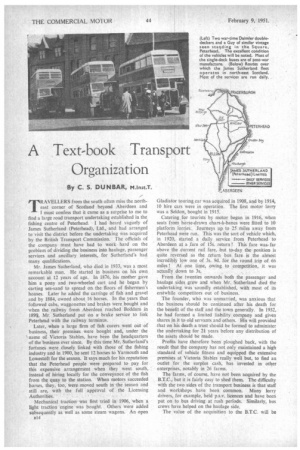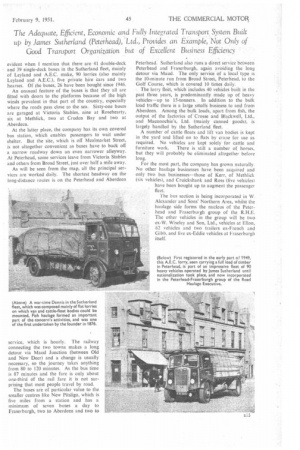A Text-book Transport
Page 48

Page 49

If you've noticed an error in this article please click here to report it so we can fix it.
Organization
By C. S. DU N BAR, M.Inst.T.
.... TRAVELLERS from the south often miss the northeast corner of Scotland beyond Aberdeen and 1 must confess that it came as a surprise to me to find a large road transport undertaking established in the fishing centre of Peterhead. I had heard vaguely of James Sutherland (Peterhead), Ltd., and had arranged to visit the district before the undertaking was acquired by the British Transport Commission. The officials of the company must have had to work hard on the problem of dividing the business into haulage, passenger services and ancillary interests, for Sutherland's had many qualifications.
Mr. James Sutherland, who died in 1933, was a most remarkable man. He started in business on his own account at 12 years of age. In 1876, his mother gave him a pony and two-wheeled cart and he began by carting sea-sand to spread on the floors of fishermen's houses. Later he added the carriage of fish and gravel and by 1884, owned about 16 horses. In the years that followed cabs, waggonettes and brakes were bought and when the railway from Aberdeen reached BOddam in 18951, Mr. Sutherland put on a brake service to link Peterhead with the railway terminus.
Later, when a large firm of fish curers went out of business, their premises were bought and, under the ' name of Victoria Stables, have been the headquarters of the business ever since. By this time Mr. Sutherland's fortunes were closely linked with those of the fishing industry and in 1900, he sent 12 horses to Yarmouth and Lowestoft for the season. It says much for his reputation that the Peterhead people were prepared to pay for this expensive arrangement when they went south, instead of hiring locally for the conveyance of the fish from the quay to the station. When motors succeeded horses, they, too, were moved south in.the season and still are, with the full approval of the Licensing
Authorities. . . .
Mechanical traction was first tried in 1906, when a light traction engine was bought. Others were added subsequently as well as some steam wagons. An open Gladiator touring car was acquired in 1908, and by 1914, 10 hire cars were in operation. The first motor lorry was a Seldon, bought in 1915.
Catering for tourists by motor began in 1916, when seats from horse-drawn chars-h-bancs were fitted to 10 platform lorries. Journeys up to 25 miles away from Peterhead were run. This was the sort of vehicle which, in 1920, started a daily service from Peterhead to Aberdeen at a fare of 15s. return ! This fare was-far above the current rail fare, but to-day the position is quite reversed as the return bus fare is the almost incredibly low one of 3s. 9d. for the round trip of 66 miles ! At one time, owing to competition, it was actually down to 3s.
From the twenties onwards both the passenger and haulage sides grew and when Mr. Sutherland died the undertaking was soundly established, with most of its erstwhile competitors out of business.
The founder, who was unmarried, was anxious that the business should be continued after his death for the benefit of the staff and the town generally. In 1932, he had formed a limited liability company and given shares in it to old servants and others. His will provided that on his death a trust should be formed to administer the undertaking for 21 years before any distribution of the assets should be made.
Profits have therefore been ploughed back, with the result that the company has not only maintained a high standard of vehicle fitness and equipped the extensive premises at Victoria Stables really well but, to find an outlet for the surplus cash, has invested in other enterprises, notably in 26 farms.
The farms, of course, have not been acquired by the B.T.C., but it is fairly easy to shed them. The difficulty with the two sides of the transport business is that staff and workshops have beers common. Many lorry drivers, for example, held p.s.v. licences and have been put on to bus driving at rush periods. Similarly, bus crews have helped on the haulage side.
The value of the acquisition to the B.T.C. will be
evident when I mention that there are 41 double-deck and 39 single-deck buses in the Sutherland fleet, mainly of Leyland and A.E.C. make, 90 lorries (also mainly Leyland and A.E.C.), five private hire cars and two hearses. Of the buses, 26 have been bought since 1946.
An unusual feature of the buses is that they all arc fitted with doors to the platforms because of the high winds prevalent in that part of the country, especially where the roads pass close to the sea. Sixty-one buses are garaged at Victoria Stables, nine at Rosehearty, six at Methlick, two at Cruden Bay and two at Aberdeen.
At the latter place, the company has its own covered bus station, which enables passengers to wait under shelter. But the site, which is off Mealmarket Street, is not altogether convenient as buses have to back off a narrow roadway down an even narrower alleyway. At Peterhead, some services leave from Victoria Stables and others from Broad Street, just over half a mile away.
As will be seen from the map, all the principal services are worked daily. The shortest headway on the long-distance routes is on the Peterhead and Aberdeen
service, which is hourly. The railway connecting the two towns makes a long detour. via Maud Junction (between Old and New Deer) and a change is usually necessary, so the journey takes anything from 80 to 120 minutes. As the bus time is 87 minutes and the fare is only about one-third of the rail fare it is not surprising that most people travel by road.
The buses are of particular value to the smaller centres like New Pitsligo, which is five miles from a station and has a minimum of seven buses a day to Fraserburgh, two to Aberdeen and two to Peterhead. Sutherland also runs a direct service between Peterhead and Fraserburgh, again avoiding the long detour via Maud. The only service of a local type is the 10-minute run from Broad Street, Peterhead, to the Golf Course, which is covered 10 times daily.
• The lorry fleet, which includes 40 vehicles built in the past three years, is predominantly made up of heavy vehicles—up to 15-tonners. In addition to the bulk load traffic there is a large smalls business to and from Aberdeen. Among the bulk loads, apart from fish, the output of the factories of Crosse and Blackwell, Ltd., and Maconochie's, Ltd. (mainly canned goods), is largely handled by the Sutherland fleet. .
A number of cattle floats and lift van bodies is kept in the yard and lifted on to flats by crane for use as required. No vehicles are kept solely for cattle and furniture work. There is still a number of horses, but they will probably be eliminated altogether before long.
For the most part, the company has grown naturally. No other haulage businesses have been acquired and only two bus businesses—those of Kerr, of Methlick (six vehicles), and Cruickshank and Ross (five vehicles) have been bought up to augment the passenger fleet.
The bus section is being incorporated in W. Alexander and Sons' Northern Area, whilst the haulage side forms the nucleus of the Peterhead and Fraserburgh group of the R.H.E. The other vehicles in the group will be two ex-W. Wiseley and Son, Ltd., vehicles at Elton, 62 vehicles and two trailers ex-French and Gibb, and live ex-Eddie vehicles at Fraserburgh itself.




























































































